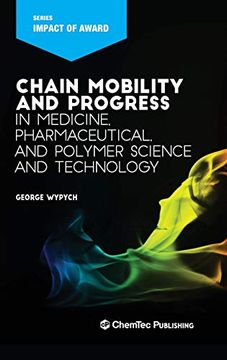Chain Mobility and Progress in Medicine, Pharmaceutical, and Polymer Science and Technology (Impact of Award) (en Inglés)
Reseña del libro "Chain Mobility and Progress in Medicine, Pharmaceutical, and Polymer Science and Technology (Impact of Award) (en Inglés)"
Chain movement, chain mobility, segmental mobility, segmental dynamics, chain orientation are the primary subjects of this monograph having utmost importance in polymer science and technology, medicine, pharmaceutical, and many other applications. Nobel Prize committee awarded in 1991 Nobel Prize in Physics to Pierre-Gilles de Gennes of Collège de France "for discovering that methods developed for studying order phenomena in simple systems can be generalized to more complex forms of matter, in particular to liquid crystals and polymers". “de Gennes’ models of polymer-chain motion” show “that a certain typical segment of a chain can move as if it were free, even in more concentrated solutions.” “The reptation model described the serpentine motion of a polymer chain within a “tangle” of surrounding polymer chains.” The book goes far beyond the analysis of the effect of the Nobel Prize on how we interpret movement within materials today and how our present perception affects many aspects of science. The introductory chapter defines principle terms and their semantics, followed by an introduction to Nobel Laureate and Award Justification and analysis of published materials until today. It is followed by the analysis of the effect of Nobel Prize on the frequency of publication of research papers and patents on the subject chain mobility.Chapter 3 contains discussion of different mechanisms used for description and interpretation of results of chain motion of macromolecular substances, such as bead-chain, bond fluctuation, Brill transition, chain diffusion, chain orientation, chemo-responsive, coarse-grained, fluorescence blob, intra- vs. inter-chain, light activated, magnetic-activated, microwave, rod chain, Rouse, shape memory, slip-link, strain-induced, tube models which today form fabric of scientific explanation of applicable facts.Chapter 4 will discuss conditions or, in other words, parameters under which chains move, including activation energy, annealing, chain absorption, chain scission, compaction pressure, configuration, confinement dimensions, crosslinks, crystallization, dynamic ratio, electrostatic interaction, entanglements, free surface, free volume, glass transition temperature, hydrophilicity, interaction length, interface layer, layer thickness, microstructure, miscible and immiscible blends, molecular weight, nanoparticles, packing density, presence of low molecular compounds (e.g., plasticizers, solvents), pressure, relaxation time, rotational motion, segmental dynamics, side chains, temperature, and time of chain movement. All these parameters are essential determinants of chain movement and their impact id discussed in separate sections of this chapter.Chapter 5 includes information on the effect of chain movement on properties of materials, such as chain alignment, chain orientation, creation of free volume, crystallization, dimensional stability, formation of porous structures, ionic transport, mechanical properties, polymer blends, polymer redistribution, proton transfer, release rate of low molecular compounds, reinforcement, self-healing, sound attenuation, steric hindrance, storage modulus, swelling, thermal expansion, thermal stability, and wear.Chapter 7 contains information on significant contributions on chain mobility for 50 polymers. The polymers selected comprise about 25% of all polymers included in Handbook of Polymers, which means that chain mobility was important subject of studies in both theoretical and practical applications.This book gives numerous examples on how to apply these findings in the developemnt of cutting-edge products for medicine, pharmacy, and polymer sciences.

